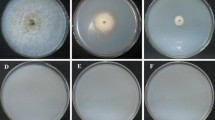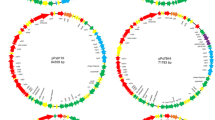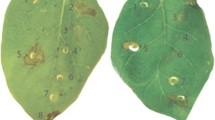Abstract
A genomic library ofPseudomonas syringae pv.aptata strain NCPPB 2664, which causes bacterial blight of sugar beet, lettuce and other plants, was constructed in the cosmid vector pCPP31. The 13.4 kbEcoRI fragment of the cosmid pHIR11, containing thehrp (hypersensitiveresponse andpathogenicity) gene cluster of the closely related bacteriumPseudomonas syringae pv.syringae strain 61, was used as a probe to identify a homologoushrp gene cluster inP. syringae pv.aptata. Thirty of 2500 cosmid clones, screened by colony hybridization, gave a strong hybridization signal with the probe, but none of these conferred to the non-pathogenic bacterium,Pseudomonas fluorescens, the ability to elicit the hypersensitive response (HR) in tobacco. Southern blot analysis ofEcoRI-digested genomic DNA ofP. syringae pv.aptata showed hybridizing bands of 12 kb and 4.4 kb. Only a 12 kb fragment hybridized in digests of the cosmids. Cosmid clone pCPP1069 was mutagenized with Tn10-minitet and marker-exchanged into the genome ofP. syringae pv.aptata. Three resulting prototrophic mutant strains failed to elicit the HR in tobacco and to cause disease in lettuce. The DNA flanking the Tn10-minitet insertions from mutated derivatives of pCPP1069 hybridized with the 10.6 kbBglII fragment of pHIR11. These results indicate thatP. syringae pv.aptata harbourshrp genes that are similar to, but arranged differently from, homologoushrp genes ofP. syringae pv.syringae.
Similar content being viewed by others
Abbreviations
- HR:
-
hypersensitive response
- Hrp:
-
mutant unable to induce HR and pathogenicity
- Psa:
-
Pseudomonas syringae pv.aptata
- Pss:
-
Pseudomonas syringae pv.syringae
- Ea:
-
Erwinia amylovora
References
Beer SV, Bauer DW, Jang YH, Laby RJ, Sneath BJ, Wei Z-M, Wilcox DA & Zumoff CH (1991) Thehrp gene cluster ofErwinia amylovora. In: Hennecke H & Verma DPS (Eds) Advances in Molecular Genetics of Plant-Microbe Interactions, Vol 1 (pp 53–60). Kluwer Academic Publishers, Dordrecht
Birnboim HC (1983) A rapid alkaline extraction method for the isolation of plasmid DNA. In: Wu L, Grossman J & Wo K (Eds) Method in Enzymology, Vol. 100 (pp 243–255). Academic Press, New York
DeFeyter R, Kaelo CI & Gabriel DW (1990) Small, stable shuttle vectors for use inXanthomonas. Gene 88: 65–72
Ditta G, Stanfield S, Corbin D & Helinski DR (1980) Broad-host-range DNA cloning system for Gram-negative bacteria: construction of a gene bank ofRhizobium meliloti. Proc. Nat. Acad. Sci. USA 77: 7347–7351
Gallie DR, Novak S & Kado CI (1985) Novel high- and low-copy stable cosmids for use inAgrobacterium andRhizobium. Plasmid 14: 171–175
He SY, Huang H-C & Collmer A (1993)Pseudomonas syringae pv.syringae harpinp ss : a protein that is secreted via the hrp pathway and elicits the hypersensitive response in plants. Cell 73: 1255–1266
Hildebrand DC, Schroth MN & Sands DC (1988)Pseudomonas. In: Schaad NW (Ed) Laboratory Guide for Identification of Plant Pathogenic Bacteria, 2nd Edn (pp 60–80). Academic Press, ST. Paul, Minnesota
Huang H-C, He SY, Bawer DW & Collmer A (1992) ThePseudomonas syringae pv.syringae 61hrpH product, an envelope protein required for elicitation of the hypersensitive response in plants. J. Bacteriol. 174: 6878–6885
Huang H-C, Hutcheson S & Collmer A (1991) Characterization of thehrp cluster fromPseudomonas syringae pv.syringae 61 and TnphoA tagging of genes encoding exported or membrane-spanning Hrp proteins. Mol. Plant-Microbe Interaction 4: 469–476
Huang H-C, Schurink R, Denny TP, Atkinson MM, Baker CJ, Yucel I, Hutcheson S & Collmer A (1988) Molecular cloning ofPseudomonas syringae pv.syringae gene cluster that enablesPseudomonas fluorescens to elicit the hypersensitive response in tobacco plants. J. Bacteriol. 170: 6748–6756
Keen NT, Tamaki S, Kobayashi D & Trollinger D (1988) Improved broad-host-range plasmids for DNA cloning in Gram-negative bacteria. Gene 70: 191–197
King ED, Ward MK & Raney DE (1954) Two simple media for the demonstration of pyocyanin and fluorescin. J. Lab. Clin. Med. 44: 301–307
Klement Z (1982) Hypersensitivity. In: Mount MS & Lacy GH (Eds) Phytopathogenic Procaryote, Vol 2 (pp 149–177). Academic Press, New York
Laby RJ & Beer SV (1992) Hybridization and functional complementation of thehrp gene cluster fromErwinia amylovora strain Ea321 and DNA of the other bacteria. Mol. Plant-Microbe Interaction 5: 412–419
Mills D & Mukhopadhyay P (1990) Organization of the hrpM locus ofPseudomonas syringae pv.syringae and its potential function in pathogenesis. In: Silver S, Chakrabarty AM, Iglewski B & Kaplan S (Eds) Pseudomonas: Biotransformations, Pathogenensis, and Evolving Biotechnology (pp 47–57). American Society for Microbiology, Washington, DC
Minardi P (1991) Histochemistry of tobacco mesophyll cell walls pretreated with bacterial-lipopolysaccharides. J. Phythopath. 131: 305–314
Minardi P (1994) Altered expression ofErwinia amylovora hrp genes in tobacco pretreated with bacterial protein-lipopolysaccharides. J. Phythopath. (in press)
Minardi P & Beer SV (1992) Effect of induced protection on the expression ofErwinia amylovora hrp-genes in tobacco leaves. Proceedings 8th Int. Conf. Plant Path. Bact. Versailles, France
Minardi P, Fede A & Mazzucchi U (1989) Protection induced by protein-lipopolysaccharide complexes in tobacco leaves: role of protected tissue free-space solutes. J. Phythopath. 127: 211–220
Nakazawa T & Inouye S (1986) Cloning ofPseudomonas genes inEscherichia coli. In: Sokatch JR (Ed). The Bacteria (pp 357–382). Academic Press
Rahme LG, Mindrinos MN & Panopoulos NJ (1991) Genetic and transcriptional organization of thehrp cluster ofPseudomonas syringae pv.phaseolicola. J. Bacteriol. 173: 575–586
Sambrook J, Fritsch EF & Maniatis T (1989) Molecular Cloning: A Laboratory Manual. 2nd Edn, Cold Spring Harbor Laboratory Press, New York
Sharma SB & Signer ER (1990) Temporal and spatial regulation of the symbiotic genes ofRhizobium meliloti in planta revealed by transposon Tn5-gusA. Gen. Develop. 4: 344–356
Silhavy TJ, Berman ML & Enquist LW (1984) Experiments with Gene Fusions. Cold Spring Harbor Laboratory Press, New York
Spaink HP, Okker RJH, Wigffelman CA, Pees E & Lugtenberg BJ (1987) Promoters in the nodulation region of theRhizobium leguminosarum. Sym. plasmid pRL1JI. Plant Mol. Biol. 9: 27–39
Staskawicz B, Dahlbeck D, Keen N & Napoli C (1987) Molecular characterization of cloned avirulence genes from race 0 and race 1 ofPseudomonas syringae pv.glycinea. J. Bacteriol. 169 (12): 5789–5794
Torriani A (1960) Influence of inorganic phosphate in the formation of phosphatases byEscherichia coli. Biochim. Biophys. Acta 38: 660–669
Valenti V, Minardi P, Guerrini F, Mazzucchi U & Pupillo P (1989) Plasma membrane NADH-duroquinone reductase increases in tobacco leaves treated with protein-lipopolysaccharide complexes. Plant Physiol. Biochem. 27: 1–8
Way JC, Davis MA, Morisato D, Roberts DE & Kleckner N (1984) New Tn10 derivatives for transposon mutagenesis and for construction of LacZ operon fusions by transposition. Gene 32: 369–379
Wei Z-M, Laby RJ, Zumoff CH, Bauer DW, He SY, Collmer A & Beer SV (1992) Harpin, elicitor of the hypersensitive response produced by the plant pathogenErwinia amylovora. Science 257: 85–88.
Willis DK, Rich JJ & Hrabak EM (1991)Hrp genes of phytopathogenic bacteria. Mol. Plant-Microbe Interact. 4: 132–138
Xiao Y, Lu Y, Heu S & Hutcheson S (1992) Organization and environmental regulation of thePseudomonas syringae pv.syringae 61hrp cluster. J. Bacteriol. 174: 1734–1741
Author information
Authors and Affiliations
Rights and permissions
About this article
Cite this article
Minardi, P. Cloning of genes required for hypersensitivity and pathogenicity inPseudomonas syringae pv.aptata . Antonie van Leeuwenhoek 67, 201–210 (1995). https://doi.org/10.1007/BF00871214
Received:
Accepted:
Issue Date:
DOI: https://doi.org/10.1007/BF00871214




